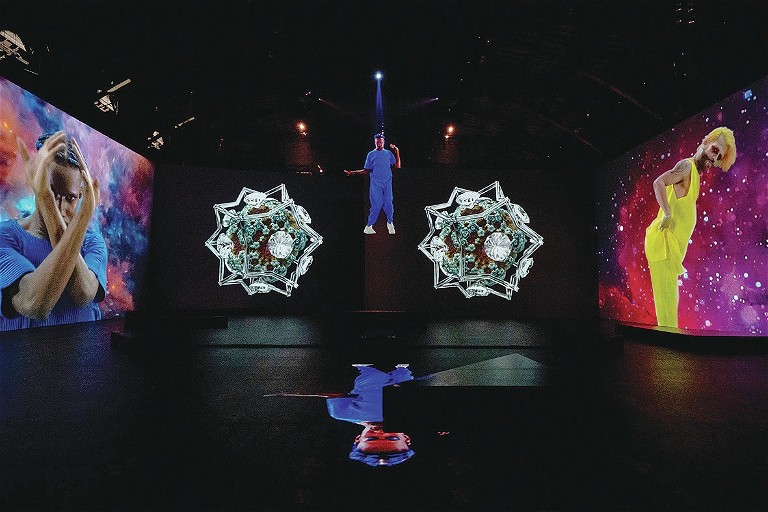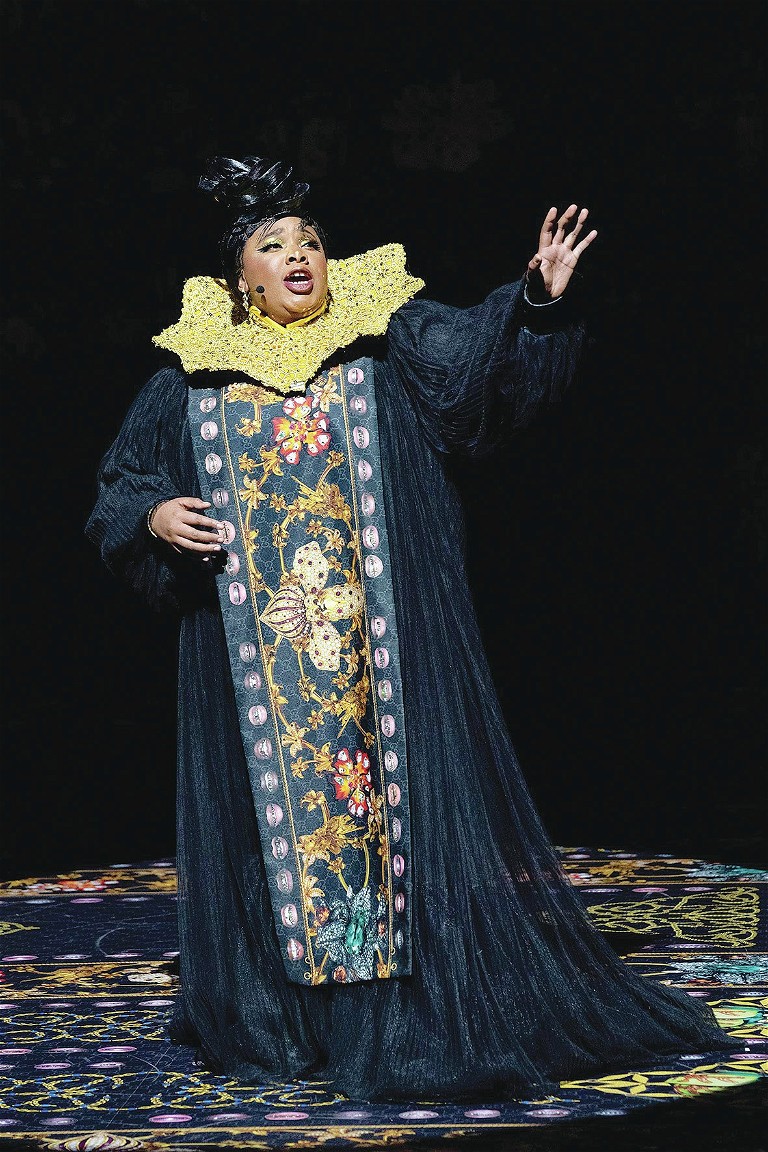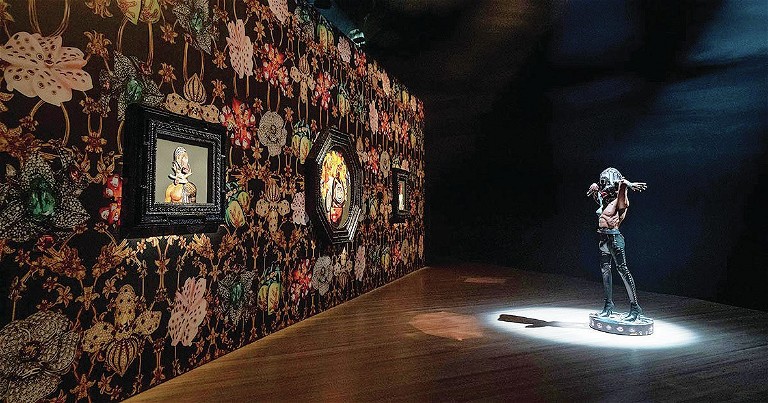Assembly is an ambitious, joyful collage of black art and voguing
Newsome layers, juxtaposes and creates conversation between multiple artistic and technological disciplines to explore the structures of oppression in search of black liberation
by BRIAN SCHAEFER

Video art and a hologram (centre) titled Wrapped, Tied & Tangled are among the exhibited pieces
Source: Rashaad Newsome Studio
THE art of collage is the art of layering, of juxtaposition, of conversation between related and unrelated materials. It’s making something greater than the sum of its parts. In Assembly, the immersive experience now at the Park Avenue Armoury through March 6, Rashaad Newsome layers, juxtaposes and creates conversation between multiple artistic and technological disciplines to explore the structures of oppression in search of black liberation. As serious as that sounds, it also exudes joyfulness.
Newsome is a multidisciplinary artist based in New York and Oakland, California, whose creative practices include photography and music as well as software engineering and community organising, all of which he brings to Assembly, along with artificial intelligence (AI), dance, sculpture and a healthy dose of academic theory. The programme itself is also something of a collage, comprising a large-scale exhibition in the Armoury’s gargantuan Wade Thompson Drill Hall; a pedagogic workshop that’s part dance class, part lecture, part exercise in self-reflection; and a 75-minute performance that most successfully fuses and embodies Newsome’s ideas. (The exhibition and daytime workshops require one ticket; evening performances require another.)

Grego-Sykes delivers a passionate spoken word in the evening performances
Source: Park Avenue Armoury
Newsome uses the Drill Hall to great effect, separating it into three distinct zones via large screens, which allows for a sense of discovery and intimacy that this vast space u sually prec lude s. Viewers enter into a storm of colour and m oveme nt pulsing from large v ideomapped walls featuring the dancers Ousmane Omari Wiles and Justin Monster that surround a central 9.14m tall hologram of solo vogue performers who hover above like fierce apparitions. The scale of the images underscores the significance Newsome places on the role of voguing in black queer culture and its central role in this exhibition.
Migrate to the back half of the hall, and you’ll encounter a 350-seat arena theatre where the workshops and performances take place, behind which is a small gallery of Newsome’s mixed-media collage and sculptural work that combine references to black queer culture and West African design within thick, glittery 19th century Dutchstyle frames. It’s a powerful marriage of history, abstract art and high fashion that proudly positions black aesthetic traditions as equal to European ones.
The works are hung on walls covered by the same breath-taking vinyl print that carpets the Drill Hall’s floors, featuring jewelled flowers in geometric patterns that include intricate motifs of golden braids and chains, as well as rows of disembodied mouths flashing gold-capped teeth. This gemstone jungle print is both luxe and sly, a flamboyant assault of bling that nods to prints by luxury brands such as Louis Vuitton and Hermès International SA while explicitly embracing blackness. (And, like those brands, you can buy Newsome’s pattern on silk scarves at the on-site pop-up boutique for US$140 [RM586.11].)
While roaming the space and observing the art, you’ll hear the constant recitation of mantras — “I am precious, worthy and valuable” — in a voice that suggests Siri on a RuPaul setting. This is the sound of Being, a two-year-old AI created by Newsome, who, we’re told by press materials, is a nonbinary voguer and educator.
Being appears to serve as Assembly’s mascot and a manifestation of Newsome’s thesis of reclaiming technology for black empowerment, appearing like the wood-panelled supermodel cousin of C-3PO on a large screen over both the gallery and the theatre arena. And it’s from that perch, in the theatre space, that Being leads the aforementioned Dance and Decolonisation workshop, which is light on dance and heavy on lecture. (Imagine being read a Wikipedia entry by your RuPaul Siri.)
The drone of academic jargon becomes depleting, which is a shame because the idea of a parti-cipatory component is a smart one. Often the missing link between contemporary art and the complex theories it hopes to illuminate is the chance to collectively debrief them. I appreciated the opportunity to be in conversation with other attendees and acknowledge the dynamic of being a white writer responding to the work of a black artist speaking largely to black audiences, but Being didn’t feel like the right facilitator for this exchange. Vulnerable statements and thoughtful questions from workshop participants deserve more than trite axioms (“You are a celestial spirit”) and generic responses written by code.
Newsome’s ideas come alive in the evening performance, which is its own collage of music (band and gospel choir), dance, poetry and dazzling graphics. It’s more concert spectacle than cohesive theatrical event, but the various components — spoken word (a passionately delivered rant against straight men by Dazié Rustin Grego-Sykes), opera (gorgeously sung by Brittany Logan in a fabulous gold Elizabethan collar), or the fantastic vogue dancing — each contains its own sense of drama and character.

A small gallery of Newsome’s work is located at the back of the hall
Source: Park Avenue Armoury
Voguing, the competitive social dance form created by queer black and Latinx members of the 1980s Harlem ballroom scene, has seen waves of mainstream visibility (think Paris is Burning and Madonna in the late 1990s) and appears to be riding one now with the popularity of shows such as HBO Max’s “Legendary”. For Newsome, voguing is a vehicle of self-love and resistance against society’s structural oppression, and his troupe of dancers exuberantly conveys how it can be both an individual panacea for life’s hardships as well as a communal protest.
The choreography — by Kameron Saunders, Ousmane Omari Wiles and Maleek Washington — delivers all the spiralling hand gestures and exciting floor dips that give voguing its strut and structure. But it also offers enlightening variations on the form by slowing it down into a kind of vogue adagio that infuses it with existential longing and a rare melancholy.
Elsewhere, the voguing mixes with movement styles such as Brazilian capoeira and hopak, a Ukrainian folk dance, to demonstrate its international reach and adaptability. The performers are all enthralling, though I was particularly drawn to Stanley Glover’s dignified intensity, Ruddy Frias’s explosive vitality and Hisyam Qumhiyeh’s playful facial expressions and whipping red ponytail.
These performers make the politics of vogue viscerally felt, rather than intellectually considered, as in the workshop. When layered and put into conversation with the stellar singers and musicians, Assembly accomplishes Newsome’s aim of honouring black struggle, ingenuity and beauty, becoming a living tapestry as rich and magnificent as his bejewelled backdrop.
When it comes to being moved by ideas, nothing beats moving. And these moving beings are far more persuasive than any nonhuman Being.
— Bloomberg